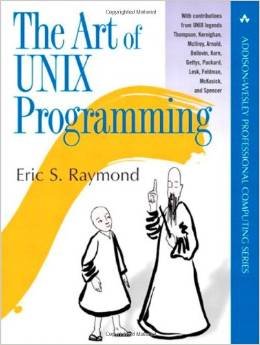The Art of Unix Programming (pdf) by Eric S. Raymond gives insight into the culture and history of Unix programming, revealing the secrets the original Unix designers used to develop software. It covers conceptual derivations such as Linux and other genetic ones like BSD (Berkeley Software Distribution) as well.
Author of the influential and popular 1997 book The Cathedral and the Bazaar, Eric Steven Raymond is a software developer, author and open source software advocate. His The Art of Unix Programming was published by Addison-Wesley in 2003, and besides this book he’s also the author of “The Cathedral and the Bazaar” and “Learning GNU Emacs”.
The pdf version of The Art of Unix Programming – 1st edition, is available here for free download. You can also buy the book from Amazon following the referral link.
Buy from Amazon: The Art of UNIX Programming (The Addison-Wesley Professional Computng Series)
Book Review:
- Title: The Art of Unix Programming
- Author: Eric Steven Raymond
- Edition: 1st
- Publisher: Addison-Wesley
- Pages: 549
- Format: pdf
- Size: 2.3MB
The Art of Unix Programming gives an overview of the Unix engineering tradition and rich design patterns. It is mainly aimed at helping programmers understand these things better to capture and overall design philosophy, engineering knowledge of the Unix, Linux, and Open Source software development community.
The book (pdf) is basically divided into four main parts: Context, Design, Implementation and Community, which all together make up a total of 20 chapters.
Context deals with philosophy, history and contrasts, detailing in the durability of Unix, basics of the Unix philosophy, origins and history of Unix, and the elements of operating-system style.
The second part Design is comprehensive; it comprises of modularity, textuality, transparency, multiprogramming, minilanguages, transformation, configuration, interfaces, optimization and complexity.
Implementation basically covers languages, tools and re-use. They detail in subjects such as Unix’s cornucopia of languages, trends for the future, a developer-friendly operating system, special-purpose code generators, version-control systems, profiling, transparency as a key to re-use, from re-use to open source, licensing issues, and more.
The last part of The Art of Unix Programming, Community talks about portability, documentation, open source and futures. Some of the subjects covered here are Unix standards, programming for portability, the Unix style, the DocBook toolchain, how to write Unix documentation, Unix and Open Source, essence and accident in Unix tradition and problems in the design and environment of Unix.
“A delightful, fascinating read, and the lessons in problem-solving are essential to every programmer, on any OS.”
— Bruce Eckel, author of Thinking in Java and Thinking in C++
The Art of Unix Programming is for those who are just beginners as well as intermediate programmers; especially those who are not familiar with Unix but have done some programming in languages such as C, C++ or Java might find this book very useful.
Buy from Amazon: The Art of UNIX Programming (The Addison-Wesley Professional Computng Series)
For those who are interested in gaining more experience and necessary skills, the book provides an extensive bibliography as well. The book also gives illustrative, practical and helpful examples whenever and wherever needed to help the readers gain a better comprehension of respective subject matter.
You can find more Unix books/pdf here.







